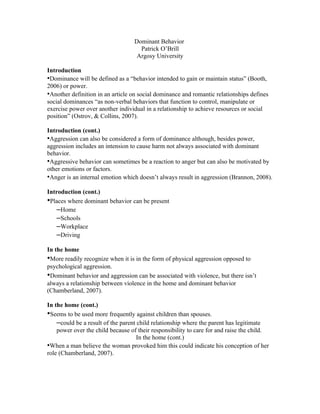
O Brilll Dominant Behavior Notes
- 1. Dominant Behavior Patrick O’Brill Argosy University Introduction •Dominance will be defined as a “behavior intended to gain or maintain status” (Booth, 2006) or power. •Another definition in an article on social dominance and romantic relationships defines social dominances “as non-verbal behaviors that function to control, manipulate or exercise power over another individual in a relationship to achieve resources or social position” (Ostrov, & Collins, 2007). Introduction (cont.) •Aggression can also be considered a form of dominance although, besides power, aggression includes an intension to cause harm not always associated with dominant behavior. •Aggressive behavior can sometimes be a reaction to anger but can also be motivated by other emotions or factors. •Anger is an internal emotion which doesn’t always result in aggression (Brannon, 2008). Introduction (cont.) •Places where dominant behavior can be present –Home –Schools –Workplace –Driving In the home •More readily recognize when it is in the form of physical aggression opposed to psychological aggression. •Dominant behavior and aggression can be associated with violence, but there isn’t always a relationship between violence in the home and dominant behavior (Chamberland, 2007). In the home (cont.) •Seems to be used more frequently against children than spouses. –could be a result of the parent child relationship where the parent has legitimate power over the child because of their responsibility to care for and raise the child. In the home (cont.) •When a man believe the woman provoked him this could indicate his conception of her role (Chamberland, 2007).
- 2. •Both men and women can exhibit dominant and aggressive behavior which seems to be more the case in egalitarian societies where woman are explicitly considered to be equal to men (Brannon, 2008). •When it is negative then men are more likely to resort to physical touch whereas women may rely on more covert strategies and nonverbal communication (Ostrov, & Collins, 2007). In the home (cont.) •Good parenting seems to include dominant behavior without associated violence. –children who were more closely monitored by their parents seemed to have more normative relationships. –less likely to be aggressive and bully or be victims of this behavior. In the school •Some social dominance in childhood can be good because it can lead to more social competent outcomes (Ostrov, & Collins, 2007). •Studies seem to indicate “preschool boys tend to use physical means of influence whereas girls tend to use verbal strategies but the overall dominant output is equal” (Ostrov, & Collins, 2007) In the school (cont.) •An aspect of dominant behavior and aggression is bullying •children who are doing the bullying usually pick on weaker children to gain dominance and social status (Veenstra, Lindenberg, De Winter, Zijlstra, Verhulst & Ormel, 2007). •Bullying is usually directed towards other children of the same sex In the workplace •When there are clear lines of authority there is a more ready acceptance of dominance assuming it is in the context of “getting the job done” In the workplace (cont.) •However often times some dominant behavior can be unrelated to completing tasks and this can be a possible cause for conflict. •More frequently conflicts in the workplace due to dominant behavior is among coworkers were there isn’t an official asymmetrical working relationship. In the workplace (cont.) •Dominance in the workplace can be the cause for production related issues. •Circumstance in today’s environment causing conflicts –Personalities –Competition –Stress
- 3. –Intolerance –Perceived inequities –Misunderstanding and others (Ramsey, 2005). In the workplace (cont.) •Almost a fifth, 18 percent of a managers time is spent dealing with workplace interpersonal conflicts among coworkers (Ramsey, 2005) •Dr. Ramsey suggests sometimes these conflicts are a result of the workplace environment and in these circumstance a solution maybe –lighten up the workplace –encouraging coworkers to consider how they say things –possibly separating coworkers –imposing gag orders –as a last resort threaten possible termination with the perspective of “get along or move along”. (Ramsey, 2005). While driving •Dominant aggressive behavior while driving which can escalate to road rage –becoming more frequent every day •Factors –limited road capacity –Situations –Environment –personality or dispositional factors –demographics While driving (cont.) •According to a statistic from 2000 there are as many as 400 billion hostile exchanges between motorists in the United States every year. •Increases in hostile exchanges have also been reported in other countries. (Sharkin, 2004) While driving (cont.) •Traffic congestion “can be a source for annoyance and stress and can negatively affect mood, behavior and health of commuters” (Sharkin, 2004). •Billboards with aggressive messages also seemed to influence drivers to be more aggressive. (Sharkin, 2004) While driving (cont.) •A study conducted using confederate drivers showed when in a closed car other drivers were quicker to honk and hold it for longer durations than when in an open convertible.
- 4. Conclusion •Dominance may have advantages but it also has disadvantages. •A double blind study looking at interpersonal relationship showed dominance can lead to success but also damage social relationships (Diekman, 2007). Conclusion (cont.) •A saying by J. K. Rowling stated, “If you want to see the true measure of a man, watch how he treats his inferiors, not his equals.” Conclusion (cont.) •Further research questions may include –Given the four possible facets of an individual’s life where dominant behavior maybe encountered could it be possible these impact each other? –When a person exhibited dominant behavior in school while growing up would they also exhibit this same behavior in their driving, a work environment later in life or even as a parent? –If someone was a victim of dominate behavior by others is it possible they’d resort to this same dominant behavior of others such as described in children’s modeling? –Would someone who is dominated in the office then go home and dominate their spouse and children? –What are the ramifications of dominant behavior beyond the specific situation it is exhibited or encountered?